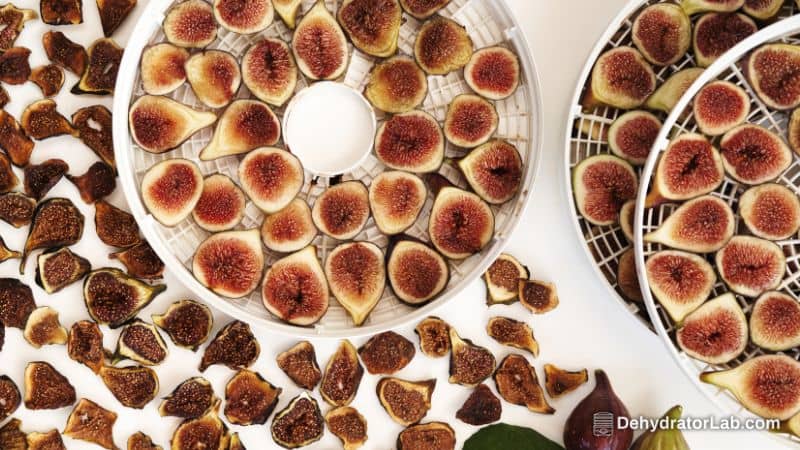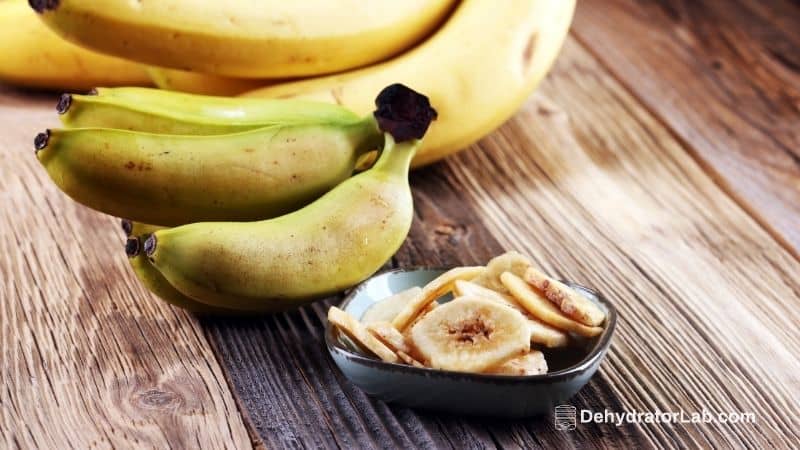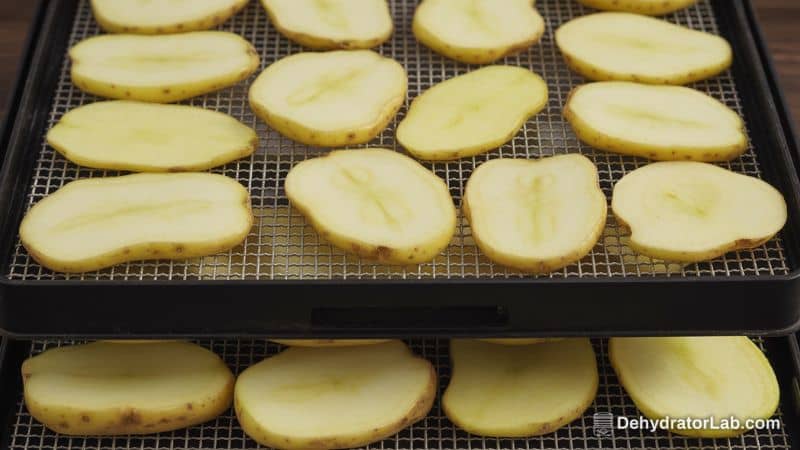
In this article:
Dehydrate Figs in a Dehydrator
You’ve got a pile of gorgeous figs and a dehydrator staring at you like, “Well?” Perfect. Let’s turn those beauties into chewy, caramel-sweet snacks you’ll stash in every jar you own.
Yes, this is easy, and yes, you’ll feel unreasonably proud when you nail it. Ready to lock in that flavor and avoid mushy fig regrets? Let’s go.
Why Dehydrate Figs?
Dehydrated figs taste like concentrated fig jam with zero mess, and they store for months when you do it right. You control texture – from tender-chewy to leathery – so you get the exact fig you love to snack on or chop into granola.
Ever wonder why store-bought dried figs sometimes taste flat? You keep more nuance at home because you dry at lower temps and avoid overprocessing.
What You’ll Need
- Food dehydrator with temperature control in the fruit range, typically 125–140°F (52–60°C).
- Ripe but not mushy figs, similar in size for even drying.
- Sharp knife and cutting board for halving or quartering.
- Trays or mesh liners to prevent sticking and allow airflow.
- Clean jars for conditioning and storage after drying.
How to Pick Figs That Dry Well
Choose figs that feel soft under gentle pressure but still hold their shape. You’ll get a better texture when figs start ripe and juicy without being jam-soft.
If sizes vary, trim large figs into quarters and smaller ones into halves so everything finishes around the same time.
Quick Prep Steps
- Wash figs gently in cool water and pat them dry to avoid trapping extra surface moisture.
- Remove stems, then cut into halves or quarters for faster, more even drying; leave tiny figs whole if you’re patient.
- Arrange in a single layer on trays with space between pieces for circulation and to prevent sticking.
Do You Need to Pretreat Figs?
Most figs don’t need pretreatment for color the way apples do, but a couple of options can tweak texture and speed. A brief blanch can check thicker skins and speed drying slightly, which helps with some varieties.
If you want a candy-like vibe, a light syrup blanch adds sweetness and a tender bite – optional, but fun if you’re aiming for a dessert-y finish.
Optional Pretreat Methods
- Hot water blanch: Dip figs in boiling water for 30–60 seconds to check skins, then move to an ice bath and dry before loading trays. Use this for firmer or thicker-skinned figs.
- Syrup blanch: Simmer pieces briefly in a light sugar syrup to boost sweetness and color retention. This creates a more candied result and is not necessary for classic dried figs.
Set the Dehydrator Temperature
Set the dehydrator to the fruit zone: 135°F (57–60°C) hits the sweet spot for figs in most consumer units. If your dehydrator just has a fruit icon, it usually maps to 125–135°F; aim for 135°F for consistent, safe drying with great texture. Avoid cranking the heat, or you’ll risk case hardening, where the outside seals before the center dries.
How Long to Dehydrate Figs
Drying time depends on cut size, fig variety, and humidity, so treat times as a range and test for doneness. As a rule of thumb, quartered figs often finish in 6–8 hours, halved figs in 8–10+ hours, and whole figs can run 12 hours or more.
Start checking around the 6-hour mark and rotate trays if your dehydrator dries unevenly.
- Quartered: 6–8 hours; fast and convenient for snacking or baking.
- Halved: 8–10+ hours; perfect for prettier pieces with a chewy center.
- Whole: 12+ hours; great for showy boards, but be patient.
How to Test for Doneness
Let a piece cool for a minute before testing, since hot fruit feels softer. Look for a firm, dry, leathery feel with no wet beads, and a bend that doesn’t squeeze out moisture; ideal figs feel pliable but not sticky-wet.
If you slice the thickest piece and see a glossy, wet center, keep going; slightly tacky is fine, syrupy wet is not.
Step-by-step: Dehydrate Figs Like a Pro
- Prep and load: Wash, stem, halve or quarter, and spread with space for airflow.
- Set temp: Choose 135°F (57–60°C) for even drying and great texture.
- Dry and rotate: Check at 6 hours, rotate trays, and flip pieces if needed for even exposure.
- Cool completely: Let figs cool on trays so surface stickiness settles and texture evens out.
- Condition in jars: Loosely pack cooled figs in jars for 24–48 hours, shaking daily; if you see condensation, they need more drying.
Why Conditioning Matters
Conditioning lets remaining internal moisture redistribute so your batch stores evenly. It prevents hidden pockets of moisture from causing mold and evens out the texture across jars. If you spot fogging on the jar, pop those figs back into the dehydrator and continue conditioning after.
Storage: Keep Them Perfect for Months
Store dried figs in airtight jars in a cool, dark place, and they’ll typically keep for several months at room temperature. For longer storage, stash them in the fridge for 6–12 months or freeze to extend quality even more.
Keep jars away from heat and strong odors, and use moisture-barrier containers for best results.
- Room temp: Cool, dark cabinet with low humidity.
- Fridge: Airtight container; extends life up to a year.
- Freezer: Freeze on a sheet, then bag to prevent clumping; label and date.
Ideal Storage Conditions
Aim for cooler temperatures and stable humidity to prevent figs from reabsorbing moisture and getting sticky. If you want to be extra careful, colder storage with moderate humidity keeps texture and flavor on point. You don’t need to overthink it at home, but cooler and drier always wins.
Texture Control: Chewy vs. Leathery
Prefer chewy? Pull at the earlier end of the time range and test the thickest piece for a soft-flexible center.
Want a firmer, trail-friendly texture? Dry longer until pieces feel evenly leathery and spring back with no tack. Ever bite into a piece that felt dry but hid moisture inside? That’s your cue to condition longer.
Slicing Choices: Halves, Quarters, or Whole
- Quarters: Fastest dry, easy for baking and chopping; go this route when figs are super juicy.
- Halves: Best balance of looks and speed; the open cut caramelizes slightly and tastes amazing.
- Whole: Gorgeous but slow; choose smaller figs and expect 12+ hours.
Flavor Upgrades That Work
You don’t need to add anything, but a light toss in lemon juice can brighten the flavor. A sprinkle of cinnamon or a touch of vanilla gives dessert vibes without overpowering the fig. If you want a candy-like fig for cheese boards, a brief syrup blanch adds a tender, glossy finish.
Troubleshooting Common Issues
- Sticky after cooling: Return figs to the dehydrator for 30–90 minutes and check again; some varieties hold more moisture and need extra time.
- Case hardening: Lower your temp to 135°F and avoid blasting heat; slice thicker pieces evenly to help the centers catch up.
- Condensation in jars: Condition longer or redry; condensation signals unsafe moisture.
Dehydrator Comparison: What Actually Matters
- Temperature control: Get a model that reliably holds 125–140°F for fruits. This single feature beats every gimmick.
- Even airflow: Horizontal airflow dries more evenly, so you rotate trays less.
- Tray capacity: Bigger capacity helps when fig season explodes and your neighbor tries to offload a tree’s worth on you.
FYI, IMO you don’t need to chase fancy features; consistent heat and airflow win every time. If you dry a lot, you’ll appreciate set-and-forget stability more than any smart app. 🙂
Creative Ways to Use Dehydrated Figs
- Snack straight from the jar for a sweet, fiber-rich bite you can toss in a bag.
- Chop into granola, oatmeal, and yogurt bowls to add chewy texture and jammy sweetness.
- Pair with cheeses, nuts, and honey on boards for a caramel note that balances salty and creamy.
Personal Notes You Can Steal
Quartered figs hit the sweet spot for speed and chew, especially with juicy late-season fruit that refuses to dry whole. Halves look prettier for grazing boards and hold shape better when you want wow moments with brie or manchego.
I rotate trays at the 6-hour mark and let everything cool on the racks so stickiness settles and jars stay clean.
Safety and Quality Tips That Save Batches
- Keep pieces uniform so you don’t over-dry small ones while waiting for big ones to finish.
- Cool completely before sealing so you don’t trap steam in jars.
- Condition every time, even for small batches; it’s the easiest insurance policy for texture and shelf life.
Quick Reference: Temps and Times
- Temp: 135°F (57–60°C) for figs.
- Time: Quarters 6–8 hrs; halves 8–10+ hrs; whole 12+ hrs.
- Doneness: Leathery, pliable, no visible wetness after cooling.
Storage Cheat Sheet
- Room temp: Cool, dark, airtight; check periodically.
- Fridge: 6–12 months for best quality.
- Freezer: Long-term; freeze on a tray first to prevent clumping.
Final Thoughts
You can dehydrate figs like a seasoned pro with a basic dehydrator, a sharp knife, and a little patience. Keep the temp at 135°F, slice to match your texture goals, and condition in jars to protect your hard work – no drama, just sweet, chewy perfection.
Craving a tiny flex? Bring a jar to your next cheese night and pretend you didn’t just make everyone’s favorite bite. 😉



